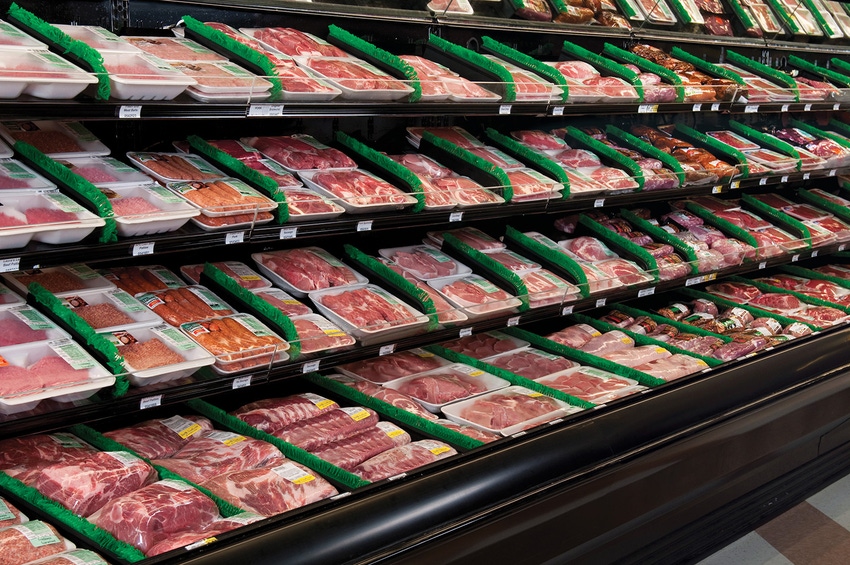Duty-free access bolsters pork exports to Mexico
Despite retaliatory duties remaining in place, June also brought an encouraging rise in pork exports to China, which were the largest in more than three years.
August 5, 2019

U.S. pork exports were above year-ago levels in both volume and value in June and thanks to a rebound in Mexico and China, pork export value was the highest in 14 months.
According to data released by USDA and compiled by the U.S. Meat Export Federation, June pork exports posted double-digit gains in both volume and value, reaching 212,887 metric tons, up 11% year-over-year, valued at $569.2 million (up 12%). For the first half of 2019, pork exports remained 2% below last year in volume (1.25 million mt) and were down 6% in value to $3.14 billion.
Pork export value averaged $56.99 per head slaughtered in June, up 7% from a year ago and the highest monthly average since April 2018. First-half export value averaged $50.05 per head, down 9% from the same period last year. June exports accounted for 27.8% of total U.S. pork production and 24% for muscle cuts only, up from 25.8% and 22.4%, respectively, a year ago. For January through June, exports accounted for 25.8% of total pork production (down from 27.3%) and 22.4% for muscle cuts (down from 23.6%).
On May 20, the 20% retaliatory duty on most U.S. pork exports to Mexico was removed as the U.S., Mexico and Canada reached an agreement on steel and aluminum tariffs. Entering Mexico duty-free for the first time in nearly a year, June exports to Mexico were the largest since January at 59,837 mt (steady year-over-year), while value climbed 13% to $119 million – the highest since April 2018.
“It’s a tremendous relief to have Mexico’s retaliatory duties on U.S. pork behind us, as the June bump in export value clearly illustrates,” says USMEF president and CEO Dan Halstrom. “Now the goal is to get back to the record-setting trend the U.S. industry established in Mexico from 2012 through 2017, prior to the metal tariff dispute. USMEF’s marketing programs have ramped up in Mexico so that we can recapture lost market share and regain momentum in this critical market for U.S. pork.”
Despite retaliatory duties remaining in place, June also brought an encouraging rise in pork exports to China, which were the largest in more than three years at 41,704 mt (up 123% year-over-year), valued at $88.5 million (up 77%). This pushed first-half exports to China 23% ahead of last year in volume (177,060 mt) and 3% higher in value ($353.1 million). For the China/Hong Kong region, first-half exports were up 4% to 224,009 mt but value declined 16% to $427.8 million. The European Union remains the primary pork supplier to China/Hong Kong. Through May, EU exports to the region were 859,030 mt, up 27% year-over-year, valued at $1.57 billion (up 34%). China/Hong Kong has accounted for 52% of EU export volume in 2019, compared to 18% of U.S. exports.
All of U.S. pork and beef’s major competitors gained tariff relief in Japan this year through the Comprehensive and Progressive Agreement for Trans-Pacific Partnership and the economic partnership agreement between Japan and the European Union, making red meat trade a major focus of the U.S.-Japan trade agreement negotiations that continued last week. Japan is the leading value destination for U.S. pork, and June exports were steady with last year in both volume (31,742 mt) and value ($131.5 million). For the first half of the year, exports to Japan were 4% below last year’s pace in volume (191,281 mt) and down 6% in value ($773.5 million). Japan’s imports of chilled U.S. pork were down just 1% in volume (100,869 mt) and 2.5% in value ($481 million), but imports of U.S. ground seasoned pork fell 24% to 41,769 mt, with value down 33% at $109.5 million. U.S. share of Japan’s GSP imports was 58%, down from 67% last year and nearly 75% in 2017.
Other first-half highlights for U.S. pork include:
Despite a June slowdown, first-half exports to Colombia were still up 20% from a year ago in volume (55,148 mt) and 13% in value ($118.8 million). Combined with excellent growth in Chile and Peru, exports to South America climbed 35% above last year’s record pace in volume (84,032 mt) and 34% higher in value ($205.4 million).
Australia is one of U.S. pork’s top-performing markets in 2019, with first-half volume up 44% to 56,338 mt and value increasing 32% to $150.1 million. With exports to New Zealand also increasing significantly this year, exports to Oceania climbed 43% from a year ago in volume (61,597 mt) and 32% in value ($166.4 million).
In Central America, where pork exports also set new records in 2018, first-half volume was up 11% to 44,614 mt while value increased 12% to $106.8 million. Exports to leading market Honduras were up slightly from a year ago, while strong growth was achieved in Guatemala, Panama, Costa Rica and Nicaragua.
Korea, Taiwan lead beef export growth; variety meat exports rebound
Beef exports were up 3% year-over-year in June to 118,677 mt. Export value ($724.8 million) increased just 1% from a year ago but trailed only August 2018, May 2019, and October 2018 for the highest monthly value total on record. First-half beef exports were down 2% from a year ago in volume (648,765 mt) but held steady with last year’s record value pace at $4.03 billion.
Beef export value per head of fed slaughter averaged $325.10 in June, up 4% from a year ago, while first-half export value averaged $312.06 per head, down 2%. June exports accounted for 15.4% of total U.S. beef production, up nearly a full percentage point from last year. For muscle cuts only, exports accounted for 12.7% of production – up from 12.3% last year and the highest ratio since July 2018. For the first half of the year, exports accounted for 14.2% of total production and 11.6% for muscle cuts – down from 14.6% and 11.9%, respectively, a year ago.
Last year South Korea surpassed Mexico as the second-largest destination for U.S. beef exports, and in 2019 it continues to close the gap on leading market Japan. Exports to Korea remained on a record pace in June, increasing 2% from a year ago to 25,118 mt (a post-BSE high), while value climbed 15% to a record $178.3 million These results pushed first-half exports to Korea 12% above last year in volume (126,879 mt) and 15% higher in value ($921.8 million). U.S. beef now accounts for 61% of Korea’s chilled beef imports, up from 57% in the first half of last year, with chilled volume increasing 7% to 26,537 mt.
Beef exports to Taiwan finished a very strong second quarter with June shipments reaching a new monthly high of 6,654 mt, up 40% from a year ago, valued at $58 million (up 46% and the second-highest on record). First-half exports to Taiwan were 16% above last year’s record pace in volume (31,132 mt) and 11% higher in value ($276.2 million).
As noted above, U.S. beef faces a significant tariff rate disadvantage in leading market Japan, where June exports totaled 29,794 mt, down 4% year-over-year, while value was down 7% to $179 million. For the first half of the year, exports to Japan were 1% below last year’s pace in both volume (157,839 mt) and value (just over $1 billion). Japan’s imports of Australian beef have also slowed this year, but first-half imports from Canada, New Zealand and Mexico were up 83%, 37% and 28%, respectively, offering a glimpse of the upside opportunities in the market when tariff rates are lowered.
“It is very gratifying to see U.S. beef posting such remarkable gains in Korea and Taiwan, and the $2 billion milestone could even be in play this year for Korea,” Halstrom says. “Exports to Japan can definitely achieve a similar trajectory if the U.S. can get back on a level playing field with our competitors, so we are encouraged by the progress in the U.S.-Japan trade negotiations.”
Other first-half highlights for U.S. beef include:
June exports of beef variety meat were the largest in two years at 28,195 mt, up 13% from a year ago, while value also climbed 13% to $79.7 million. This pushed first-half export volume even with last year at 158,466 mt while value increased 8% to $472.9 million. The large June increase was primarily driven by growth in Japan and Indonesia, while exports to Egypt rebounded from last year’s low levels.
Though first-half export volume to Mexico was down 3% year-over-year to 114,541 mt, export value increased 6% to $539.1 million. Beef muscle cut exports to Mexico slowed in June but still finished the first half up 4% from a year ago in volume (70,333 mt) and 8% in value ($422 million).
U.S. beef muscle cuts also have a rapidly growing presence in Colombia, where first-half muscle cut exports increased 29% from a year ago in volume (1,919 mt) and 36% in value ($11.2 million). Combined beef and beef variety meat exports to Colombia were up 1% from a year ago to 2,991 mt while value climbed 27% to $12.4 million. First-half exports to Chile, the top South American market for U.S. beef, increased 5% to 6,144 mt, with value up 7% to $34.3 million.
The Dominican Republic has emerged as a strong growth market for U.S. beef, with first-half exports soaring 57% above last year’s record pace in volume (4,524 mt) and gaining 47% in value to $36.2 million.
Fueled by strong growth in the Philippines and Indonesia, first-half exports to the ASEAN region increased 23% from a year ago in volume (26,711 mt) and 8% in value ($132.4 million).
U.S. lamb exports remain well ahead of 2018 pace
June exports of U.S. lamb totaled 1,073 mt, up 6% from a year ago, but value fell 21% to $1.73 million. For the first half of 2019, lamb exports were up 42% year-over-year in volume (7,783 mt) and 17% in value ($13.2 million). Mexico has been the primary growth driver for U.S. lamb, with first-half exports to Mexico climbing 52% from a year ago in volume (6,762 mt) and 33% in value ($6.7 million). Exports also showed promising growth in the Dominican Republic, Bermuda, Panama and Guatemala.
Source: U.S. Meat Export Federation, which is solely responsible for the information provided, and wholly owns the information. Informa Business Media and all its subsidiaries are not responsible for any of the content contained in this information asset.
About the Author(s)
You May Also Like



